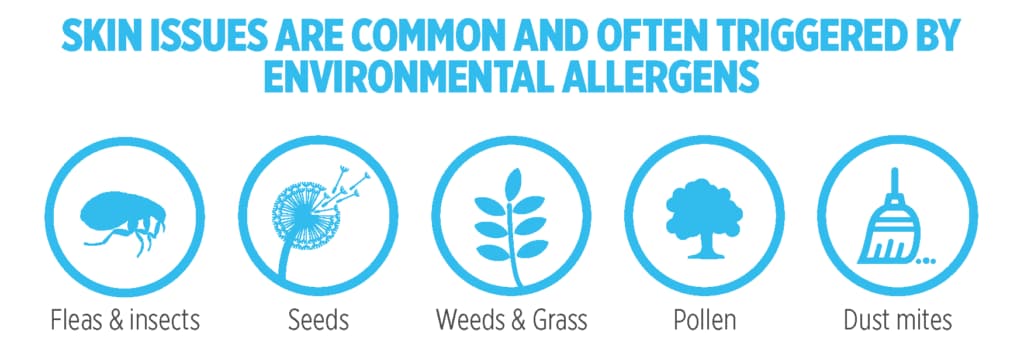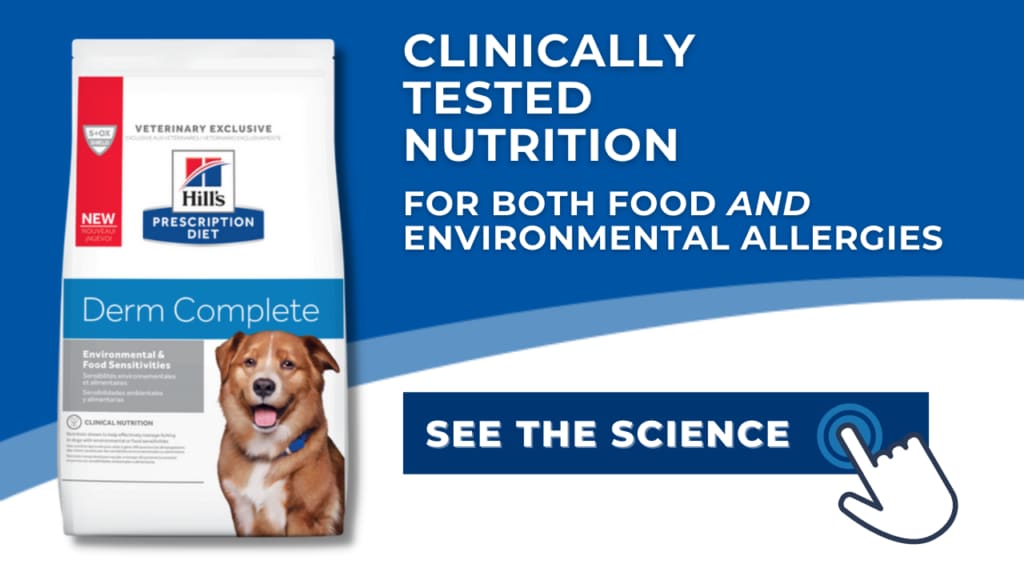Can dogs have both cutaneous food allergy and atopic dermatitis?
Allergic dermatitis (with its myriad triggers) is everywhere. Atopic dermatitis (environmental allergy) is amongst the most common causes of pruritus (itch) in the dog but, frustratingly, there is no singular diagnostic test that can definitively confirm this diagnosis for us on the clinic floor.
Many conditions can cause pruritus and thus mimic atopy. One of these mimics is cutaneous food allergy which can only be diagnosed by undertaking a very rigorous restriction-provocation diet trial. Clinicians must adopt a systematic approach to making a definitive diagnosis of allergic dermatitis and elucidating the specific trigger (or triggers) for a given patient (please see my previous blog on Canine Atopic Dermatitis for a capsule summary of this diagnostic algorithm).
So, can dogs have both cutaneous food allergy and atopic dermatitis?
The role of nonenvironmental (primarily food) allergens in the pathogenesis of canine atopy is controversial. Food-associated allergic disease and atopic dermatitis frequently co-exist in people, especially in children. Evidence to suggest that the same is true in companion animal species is scant at best. Experts agree that we need to better unravel the immunopathophysiology of cutaneous food allergy in dogs before we can examine the interrelationship between environmental and nonenvironmental factors as triggers for clinical atopic dermatitis.

Concurrent environmental allergies
In the absence of a definitive evidence base, we often resort to the anecdote of specialists to assist with management of tricky cases. Many of us have encountered the odd allergic dog that benefits somewhat from a strict diet trial (with the required flare of pruritus on provocative re-challenge to definitively diagnose a cutaneous food allergy); however, even with ongoing diligent adherence to an appropriate diet, allergic pruritus persists at an unacceptable level. These dogs, by elimination, are diagnosed with concurrent environmental allergy that responds to antipruritic therapy. For this subset of dogs with clinical atopic dermatitis, it appears that food allergens act as one of the triggers for their syndrome.
Triggers
So, to answer the question posed in the title; yes, cutaneous food allergy and atopic dermatitis (environmental allergy) can seemingly co-exist, however, this appears to be true of only a small subset of allergic canine patients. Almost invariably, in my experience, the primary driver of the allergy symptomatology is a combination of environmental triggers (pollens, moulds, house dust mites) while food triggers play a relatively minor role. These patients require a multimodal treatment regimen designed to manage both categories of trigger: environmental and food.

Nutritional management

I’ve had great success in such cases using the Hill’s Prescription Diet Derm Complete which will help prevent food allergy flares (presuming egg protein is novel for the patient based on a thorough dietary history), reduce inflammation in the skin due to environmental allergy and bolster the skin barrier to minimise ongoing percutaneous absorption of problematic environmental triggers. In these cases, this diet works synergistically with systemic antipruritic and topical treatments to optimise patient quality of life.
Dr Callum Bennie, BSc(Vet), BVSc, MS, DACVD , Board Certified Veterinary Dermatologist
While studying veterinary science at the University of Sydney, Dr Callum Bennie conducted research into antibiotic therapy for mycobacterial skin diseases in cats – a research project that sparked his love of veterinary dermatology. After working in small animal practice in Canberra and Sydney he undertook specialty training in dermatology at Colorado State University’s James L. Voss Veterinary Teaching Hospital. Now working for the Veterinary Dermatology Clinic in Sydney, Callum is passionate about all aspects of dermatology and enjoys teaching veterinarians how to approach skin and ear disease.

To learn more, complete a complimentary short course on the Nutritional Management of Pruritic Dogs
